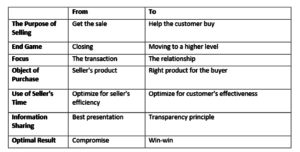If Selling Is Too Hard, You’re Doing It Wrong
Many fine sales authors will tell you that an essential ingredient in selling—perhaps the essential ingredient—is effort. Gumption, grit, hustle, sweat—whatever the word, the image it conveys is that success in selling is tough. No pain, no gain.
Selling is a lot like football, this view says: the team that exerts the most effort is the team that wins. And there is a lot of truth in that viewpoint.
But consider another truth. Think about hitting a golf ball. As anyone who’s tried doing that can attest, the quality of your golf shot is in inverse proportion to your effort. That pleasing “thwock” of a well-struck iron almost never comes from trying hard.
Instead, the “trick” in golf is not how hard you swing—it’s how smooth, relaxed, and “at ease” your swing is. If you’re swinging too hard, you’re almost certainly doing it wrong. And there’s a lot of truth in that viewpoint as well.
I’ve learned that most dichotomies like this are false. Selling isn’t only like football or like golf. It’s both, in different aspects. But that’s a different article. This article is about just one side—the golf side, if you will, where if you’re working too hard at selling, you’re doing it wrong.
Adam Smith, Competition, and Selling
Blame it on Adam Smith’s The Wealth of Nations, if you will. The Scottish moral philosopher and economist famously claimed that by the self-oriented struggling of the butcher and the baker, the “invisible hand” of the market makes itself known by balancing out all for the greater good. Out of individual selfishness grows the maximum collective good.
While Smith has been unfairly characterized as arguing against regulation and in favor of unfettered free markets, there’s no question that his powerful formulation rhymes with competition—individuals seeking their own betterment. Perhaps ever since, business has been full of metaphors from war and sports. And nowhere are those metaphors more prevalent than in sales.
Here’s a partial list for just one sport alone: pitch, curve ball, hitting cleanup, bottom of the ninth, pinch hit, get our signals lined up, strike out, bases loaded, don’t swing at the first pitch, home field advantage, double play, we’re on the scoreboard, leaving men on base, pop-up, foul ball, home run hitter, shut-out, and so on.
Here’s the thing about sports metaphors: they’re all about competition. Real Madrid vs. Barca. Yankees vs. Red Sox. All Blacks vs. Wallabies. Seller vs. competitor.
And—most of all—seller vs. buyer.
Selling without Competition
It’s hard for most people to even conceive of selling without that competitive aspect between buyer and seller. Isn’t the point to get the sale? Isn’t closing the end of the sales process? If a competitor got the job, wouldn’t that be a loss? And why would you spend time on a “prospect” if the odds looked too low for a sale?
When we think this way, we spend an awful lot of energy. It’s hard work—particularly because much of it is spent trying to persuade customers to do what we (sellers) want them to do. And getting other people to do what we want them to do is never easy (if you have a teenager and/or a spouse, you know this well).
There is another way. It consists in simply and basically changing the entire approach to selling.

The first approach is the traditional, competitive, zero-sum-thinking, buyer vs. seller—the age-old dance that to this day gives selling a faint (or not-so-faint) bad name. It is one-sided, seller-driven, and greedy.
The new social media capabilities have not made this approach to selling go away—they have empowered it. Just look at your inbox, spam filters, LinkedIn requests, Twitter hustles, and pop-up ads on the Internet.
And boy do you have to work hard to sell that way.
The second approach is different. The fundamental distinction is that you’re working with the buyer, not against the buyer. Your interests are 100% aligned, not 63%. If you do business by relentlessly helping your customers do what’s right for them, selling gets remarkably easier.
You don’t have to think about what to share and what not to. You don’t have to control others. You don’t have to white-knuckle meetings and phone calls because there are no bad outcomes.
Selling this way works very well for one fundamental reason: all people (including buyers) want to deal with sellers they can trust—sellers who are honest, forthright, long-term driven, and customer-focused. All people (including buyers) prefer not to deal with sellers who are in it for themselves, and constantly in denial about it.
This is the golf part of selling: the part where if you lighten up, relax the muscles, let it flow, you end up with superior results. And there’s a whole lot of truth to that view. If you’re working too hard, you’re not getting the sale.




Great piece on intention Charlie; thank you for this.
Great piece on intention Charlie; thank you for this.